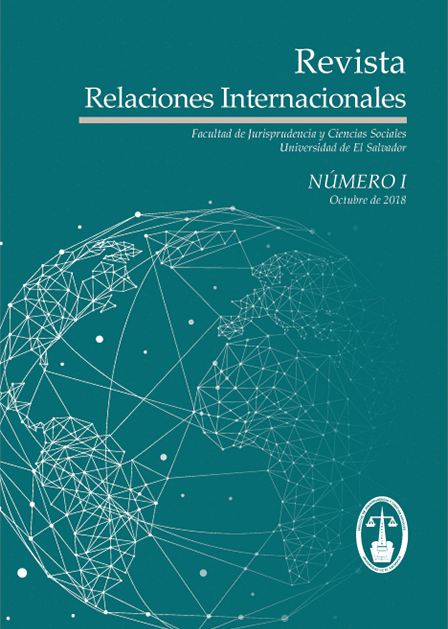Impact of the developmental state in East Asia
Keywords:
Economic expansion, East Asia, Japan, Korea, ChinaAbstract
The main objective of this article is to explain the economic rise of China, South Korea and Japan, based on developmental state theory. Through a qualitative and descriptive quantitative analysis, it is intended to answer the questions: What has been the impact of the developmental states: Japan, South Korea and China in their respective economic expansions? And what have been the characteristics that these countries have had in common in this process? This swill focus on the following specific aspects for each country and at the same time in common: intervention by the state (protection of certain productive sectors), stimulation of the national production as well as its exportation, and business conglomerates.
It can be said that China’s policy focused on “four modernizations” plus “four principles”: agriculture, industry, science and technology, and defense via the socialist, dictatorship of the proletariat, leadership of the Communist Party of China (CPC) and thinking of Marx-Lenin-Mao Zedong principles. South Korea, concentrated on the implementation of five-year plans focused on different strategic sectors, and on efficient educational training. Japan, its policy was focused on the education of the population; in granting privileges such as the distribution of raw materials, subsidies, rationalized credits, among others, mainly to the coal and steel sector, and the generation of new industries such as automobiles, heavy electrical machinery, computers and petrochemicals, and for this, the government applied measures as a special tax, import quotas, accelerated depreciation, among others (Nishijima 2009, 9).
At the end it is concluded that the impact of the developmental state on the economic success of the three countries analyzed, was of vital importance in the economic expansion of these East Asian countries, proving that, without the active participation of the developmental state, the economic performance of these three nations would not have reached the achieved dimensions.
Downloads
References
Gordon White y Robert Wade, “Developmental states and markets in East Asia: an introduction”, en Developmental States in East Asia (1988): 1-29.
“Indicadores de Desarrollo Mundial. Banco Mundial, 2016”, Banco Mundial, Accedido el 9 de marzo de 2017, http://databank.worldbank.org/data/reports.aspx?source=world-developmentindicators#.
Fernando De la Cruz Prego, “Los Estados desarrollistas en el Este Asiático: aportaciones institucionales y límites históricos”, Revista Iberoamericana de Estudios de Desarrollo, n°3 Vol 2 (2014): 26-49.
Gordon White y Robert Wade, “Developmental states and markets in East Asia: an introduction”. Erik Baark, “The Chinese State and Its Role in Shaping China’s Innovation System”, en The Asian Developmental State (2016): 159-173.
Yin-wah Chu, The Asian Developmental State (UK: Palgrave Macmillan, 2016), 4.
Gordon White y Robert Wade, “Developmental States and markets in East Asia: an introduction”.
Eugenio Bregolat, La segunda revolución china. Claves para entender al país más importante del siglo XXI (Buenos Aires: Capital Intelectual, 2011), 31.
Luciano Bolinaga, China y el epicentro del Pacífico Norte, Colección UAI-Investigación (Buenos Aires: Editorial Teseo, 2013).
Wan Jiangping, Hui Zhang, Xiaoyao Wan y Weiping Luo, “The Business Ecosystem of the Chinese Software Industry”, Scientific Research. Vol.3 No.2, (2001). Article ID:5450, DOI:10.4236/ib.2011.32018.
Huanjun, Hans van Ees y Robert Lensink, “The Role of Business Groups in China’s Transition”, (Conferencia: 19th CEA conference in Cambridge University, UK, 2008).
Kook Boo Yang, “La experiencia coreana: expansión comercial y crecimiento”, en La República de Corea hoy: economía, sociedad, relaciones internacionales, ed. por Jaime Silbert (Córdoba, Argentina: Comunicarte Editorial, 1997), 93-102.
“Understanding South Korea’s education system”, Middlebury Institute of International Studies at Monterey, accedido el 10 de marzo de 2017,http://sites.miis.edu/southkoreaeducation/diversity-and-access/.
Woo Jun In, “The strategic management of korean and japanese big business groups: acomparison study between Korean General Trading Companies and Japanese Sogo hoshas” (Tesis doctoral, University of Birmingham, England, 2009). http://etheses.bham.ac.uk/258/1/ Jun09PhD.pdf.
Luciano Bolinaga, “La inserción coreana en el epicentro pacífico norte. Entre el aliadonorteamericano y el socio chino 1989-2009” (Conferencia, Quinto congreso nacional de estudios coreanos, 2009), 693-711.
Ricardo Hausmann, César Hidalgo, Sebastián Bustos, Michele. Coscia, Alexander Simoes y Muhammed Yildirim, The atlas of economic complexity. Mapping paths to prosperity. (Harvard University, Massachusetts Institute of Technology Media Lab), acceso el 9 de marzo de 2017, http://atlas.media.mit.edu/static/pdf/atlas/AtlasOfEconomicComplexity.pdf.
Innovation and Development Network, IDN, “Development of trading companies in South Korea: story of General Trading Companies from 1970s to 1990s” (Case Studies on Innovation and Development No 2011-010, 2011).
Woo Jun In, “The strategic management of korean and japanese big business groups: a comparison study between Korean General Trading Companies and Japanese Sogo Shoshas” (Tesis doctoral, University of Birmingham, England, 2009), 73.
Shoji Nishijima, “Desarrollo Económico y Política Industrial de Japón: Implicaciones para Países en Desarrollo” Clasificación JEL: L50, N65. O53. RIBE Discussion Paper Series No. 246 (2009).
Alberto Torres, Plácido Cruz, y Francisco Ruiz, “Políticas e Instrumentos para el Fomento del Sector Exportador en Japón: Elementos Clave para el Crecimiento Económico”, Revista Mexicana de Estudios sobre la Cuenca del Pacífico, Tercera Época, Volumen 3, Número 6. (2009).
Son “monopolios verticales controlados por una sola familia. Una empresa matriz, en la mayoría de los casos un banco, era propietaria de varias empresas sucesivas, cada una de las cuales conformaba un eslabón de una cadena productiva”. Véase en el sitio web: https:// nambanjapon.wordpress.com/2011/06/15/los-conglomerados-empresariales-i-los-zaibatsu/
Woo Jun In, “The strategic management of korean and japanese big business groups: a comparison study between Korean General Trading Companies and Japanese Sogo Shoshas” (Tesis doctoral, University of Birmingham, England, 2009).
Downloads
Published
How to Cite
Issue
Section
License
Copyright (c) 2018 Revista Relaciones Internacionales

This work is licensed under a Creative Commons Attribution-NonCommercial 4.0 International License.
The authors transfer the copyright rights in favor of the Faculty of Jurisprudence and Social Sciences of the University of El Salvador (through Aequus Editorial) to include their writing in Revista Relaciones Internacionales.








